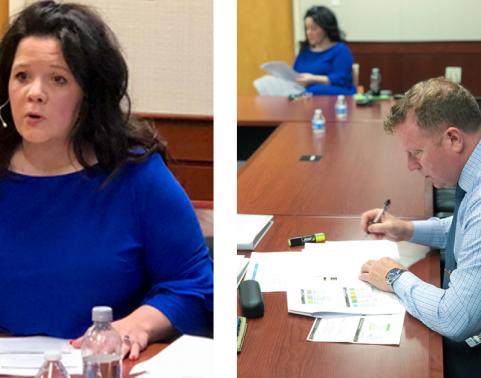8 key takeaways from GFIM Industry Day

PEO EIS hosted its very first virtual industry day on March 20 to acquire industry feedback about an Army plan to award at least three Other Transaction Authority (OTA) prototypes demonstrating business processes that support deploy-to-redeploy and retrograde (D2RR) of materiel.
The Global Force Information Management (GFIM) program will automate the Army’s core D2RR business processes—revolutionizing the way data is created and transmitted to people who man, equip, train, resource and ready our force.
GFIM Industry Day was originally designed to be a live event at Fort Belvoir’s Thurman Hall supplemented by a livestream to reach a wider audience of nontraditional contractors. In response to social-distancing restrictions developed to slow the spread of COVID-19, PEO EIS made GFIM Industry Day an exclusively virtual event. PEO EIS also hosted 18 one-on-one sessions with industry that were exclusively virtual.
“GFIM Industry Day and the 18 one-on-one sessions enabled the Army to understand industry’s capabilities and constraints,” Mary Harvey, acquisition manager for the Strategic Initiatives Group at PEO EIS, said. “Industry’s feedback will help us refine our requirements so we can deliver the best solution to our stakeholders.”
More than 120 people representing 66 companies registered for GFIM Industry Day, which was livestreamed over Facebook and YouTube. The 90-minute livestream featured five speakers in three locations. Speakers answered 11 questions submitted via text and YouTube.
Key takeaways from GFIM Industry Day are summarized below.
The Army will award OTA prototypes.
OTA prototypes are not subject to many provisions in the Federal Acquisition Regulation (FAR) and are similar to commercial contracts, according to Kyle Burke, a program analyst at PEO EIS. With the OTA framework, the Army can go straight from prototype to production. “A sole-source-award justification is not required,” Burke said. “We can go directly into a FAR contract or another OTA agreement.”
“The OTA process helps the Army modernize IT better and faster,” said Lori Mongold, chief of the Department of the Army Management Office-Strategic Operations Enterprise (DAMO-SOE) and GFIM CMO.
The Army needs a Dynamic Force Structure (DFS) prototype.
The Phase 1 DFS prototype should demonstrate an integrated planning, programming and production capability (IP3C) that serves as the single entry point for conducting force management activities for an Army “at rest” and “in motion.”
The Army currently has 12 disparate systems that are designed to ensure that logistics and pay systems match up to where Soldiers and equipment are and need to be. These 12 legacy systems will sunset and be replaced by GFIM: an integrated, interoperable enterprise capability. The accurate and timely data produced by GFIM will help the Army be more dynamic, agile and responsive.
The Army needs a Dynamic Force Employment (DFE) prototype.
The Phase 2 DFE prototype should demonstrate an integrated solution that builds off Phase 1 success by addressing the remaining GFIM capability requirements to automate D2RR sub-processes that guide force generation, employment, sustainment, re-deployment and regeneration and fully enable DFE.
“GFIM is going to change how we man and equip,” Brig. Gen. Martin Klein, director of DAMO-SOE, said.
“GFIM will enhance our ability to continue to aggressively deploy and employ our forces,” Mongold said. “Dynamic Force Employment gives the Army the ability to deploy and employ at the level that’s actually required to do the mission.” GFIM will help the Army move capabilities wherever they are needed “so we have the right people at the right place at the right time with the right equipment for the right mission,” Mongold said.
The prototypes support the Global Force Management Data Initiative (GFM DI).
“The GFM DI brings a hierarchical relationship to data,” Mongold said. “For example, if I were to ask for a dog team, I would need three personnel who have a Military Occupational Specialty. I would also need a dog, weapons, vehicles, radios and sites to store equipment. GFIM gives you that relationship to that capability that a combatant commander is requesting. This prototype has to be able to link to the lowest level of data. That also means we have to be able to get down to the individual. And we also have to get down to crew and squad platforms.”
The Army needs automated workflows.
“We know for this particular requirement that there are commercial software solutions that can handle automated workflows,” Burke said.
“This prototype should show us that we don't have to take so many manual steps in our business processes,” Mongold said “The first time that somebody enters data should be the only time that it has to be entered.”
The Army needs cloud-agnostic tools.
“We are trying to utilize as many cloud-agnostic tools as possible,” Mongold said, noting that GFIM needs to be interoperable with a hybrid-cloud environment.
The Army needs a commercial solution with zero custom code.
The Army is seeking a commercial-off-the-shelf solution to support GFIM. The Army asked companies interested in the GFIM requirement to describe their approach to achieving zero custom code.
The Army plans to award at least three prototypes in September.
The Army plans to award at least three best-value, fixed-price prototypes in September 2020, according to the current acquisition strategy.
Companies will “deliver prototypes that serve as a baseline for a continued configuration and then move into the production environment,” Mongold said. “The intent is to rapidly demonstrate those prototypes so we can understand how quickly we can deliver this solution to the Army.”
GFIM RESOURCES
Work for Us
Join a winning team! Search for job opportunities with PEO Enterprise.
Work with Us
Help support important missions. Explore ways your company can work with PEO Enterprise.